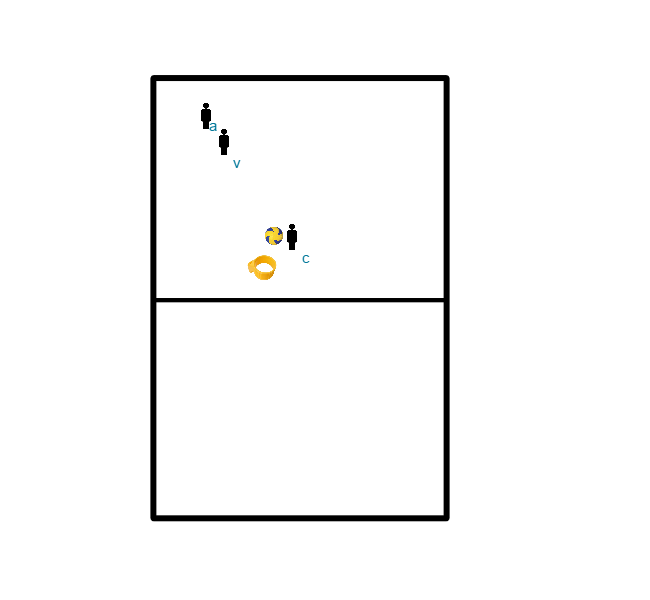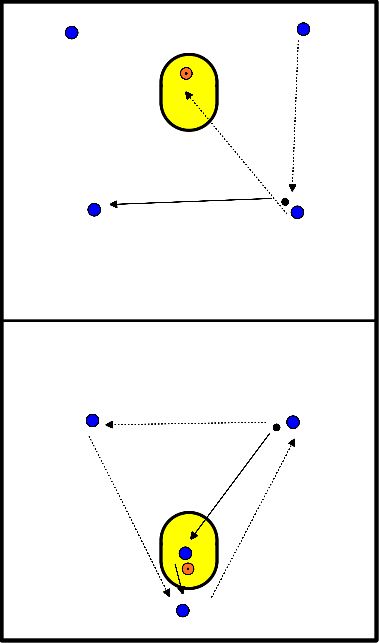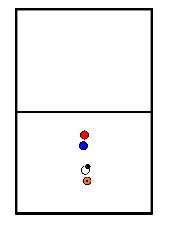Korfball drills
- make 2 groups
- the attack takes the ball from the trainers.
- When the defence has intercepted the ball, they return it to the trainers.
- When they have scored, the team gets a bonus and is allowed to take the ball back.
- 1 of the young trainers can act as referee to gain experience
2 children stand near a post. 1 attacker and 1 defender.
- The attacker may move around the post, towards the post and away from the post.
- The defender always stays with his back to the post and follows the defender.
- At a given moment, the attacker is given the ball by the trainer. The defender must then move directly towards the attacker and raise his hands.
In short: practicing various shooting variations in a fun competition form.
Organization: per group a post and a ball, the posts are preferably (but not necessary) arranged in a circle or rectangle. The number of people per group is less important (but all groups are about the same size).
- The first task for the groups is to score 10 goals.
- When you have completed this assignment, the person who scored the last goal runs to the trainer to pick up the next assignment.
- Which group completed all the assignments first?
- In the meantime, the trainer walks around encouraging or correcting where necessary.
- He has a piece of paper with him with a row of assignments on it. When someone gets to get the next assignment, first ask which one has just been completed (this can vary quite a bit over time) and then give the next assignment.
- An example list: 5 walk-through balls, 5 penalty throws, 5 4-meter shots, 5 walk-through balls from behind the post, 5 shots behind the post.
- 3 men per post.
- Player A starts as attacker for the post.
- Player V starts as defender at 1.5 arm's length from the shooter.
- Player C starts with the ball as catcher/feeder.
- Attacker A must try to score in a 1 to 1 duel.
- It doesn't matter how (distance, dodge, dlb).
- The job of defender V is to follow the attacker continuously at 1.5 arm's length.
- If the attacker has the ball in his hands, the defender must close.
- The defender must not tap or block the balls.
- The V must show that he or she is near the attacker but must allow the shot.
- This can be done by the defender placing her hand just above the attacker's shoulder.
- Switch positions after 1 minute .

- There is someone with a ball under the pole, someone in front of the pole at shooting distance and someone at about 1.5/2 m from the shooter with his face towards the pole.
- The shooter chooses one side and gets the ball.
- The defender is only allowed to turn around when the ball is loose and must therefore respond properly.The defender may not try to block the ball into the pass, but may try to block the shot.
- This can be done as an extension
In short: practicing various shooting forms in a fun competition form.
Organization: a post and a ball per group, the posts are preferably (but not absolutely necessary) arranged in a circle or rectangle. Groups 3-3-2
The first task for the groups is to score 10 goals. When you're done with that, the maker of the last goal walks to the trainer to pick up the next assignment. Which group completed all assignments first?
Assignments:
- 5x walk-through balls
- 5x penalty throws
- 3x swerve balls
- 7x short shots
- 4x 4-meter shot
- To finish the training, play a game format of 4 to 4 on 1 post.
- Make sure you build from 4-0, and go to the 3-1 with a large triangle.
- A quick scoring opportunity has to be created from the big triangle.
- If possible, create a scoring opportunity immediately after the rebound has been captured, if this doesn't work then rebuild from 4-0.
- THE BALL PACE IS HIGH IN THE 3-1.

- Pair of two by a pole.
- Each pole has three points.
- If a score is made on a pole, one point is subtracted.
- The pole is defended by a pair.
- The first pair that has zero gets 'a donkey' as an extra point.
- You lost as a pair when you have zero.
- The last pair remaining has won.
- Note: as a pair you are defending your own post but you can be attacked by six opponents.
- It is not allowed to score twice on the same post.
- Group of 3 by a post
- 1 defender, 1 passer and 1 attacker
- the attacker must score as much as possible in 30 seconds
- the defender must ensure that this happens as little as possible

- Ball in the front of the box.
- Other attacker at the back of the box.
- The one in the back of the box should try to get into the front of the support.
- Defender must prevent that
- 3 attackers against 2 defenders.
- Attack within a radius of about five meters around the post.
- All attackers are allowed to shoot.
- The defenders must try to score as few goals as possible.
- 5 x 1 minute. Skip position after each minute.
- If the number is correct, you can train specific zone defense at this exercise: Zone defensing.
- The defenders let go of their opponents as soon as they get further than six meters from the pole.
- The defender then has only one task: intercepting the ball by picking up the rebound.
- This includes voluntarily letting go of distance through the attack.
- After all, if the ball is not shot, it cannot be caught.
- We play 3:3 or 4:4 around the post without any shot or breakthrough
- Defender only focused on his own opponent.
- You do position yourself in such a way that you can always see the ball but cannot pass the defender over the back side
- The exercise is for the defender to be further away from the defenders if the ball is also far away from the attacker. If the attacker has the ball, the defender makes sure it is connected







